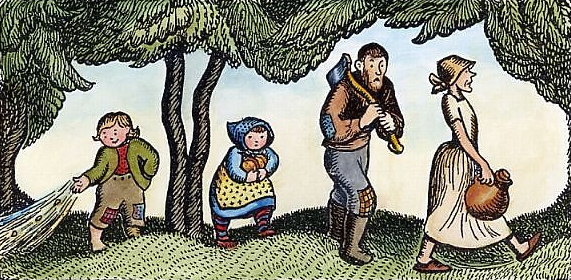Hansel leaving a trail o pebbles.
Hansel allows you to instrument Clojure[Script] forms and entire namespaces, so they leave a trail when they run.
It is ment as a platform to build tooling that depends on code instrumentation, like debuggers.
Clojure QuickStart
Basic instrumentation
(require '[hansel.api :as hansel]) ;; first require hansel api
;; Then define your "trace handlers"
(defn print-form-init [data]
(println "[form-init] data:" data))
(defn print-fn-call [data]
(println "[fn-call] data:" data))
(defn print-fn-return [{:keys [return] :as data}]
(println "[fn-return] data:" data)
return) ;; must return return!
(defn print-expr-exec [{:keys [result] :as data}]
(println "[expr-exec] data:" data)
result) ;; must return result!
(defn print-bind [data]
(println "[bind] data: " data))
;; If you have any form as data you can instrument it with
;; hansel.api/instrument-form, providing the tracing handlers you
;; are interested in. It will return the instrumented form
(hansel/instrument-form '{:trace-fn-call dev/print-fn-call
:trace-fn-return dev/print-fn-return}
'(defn foo [a b] (+ a b)))
;; If you want to evaluate the instrumented fn also you
;; have a convenience macro hansel.api/instrument also providing
;; your tracing handlers
(hansel/instrument {:trace-form-init dev/print-form-init
:trace-fn-call dev/print-fn-call
:trace-fn-return dev/print-fn-return
:trace-expr-exec dev/print-expr-exec
:trace-bind dev/print-bind}
(defn foo [a b] (+ a b)))
;; then you can call the function
(foo 2 3)
;; and the repl should print :
;; [form-init] data: {:form-id -1653360108, :form (defn foo [a b] (+ a b)), :ns "dev", :def-kind :defn}
;; [fn-call] data: {:ns "dev", :fn-name "foo", :fn-args [2 3], :form-id -1653360108}
;; [bind] data: {:val 2, :coor nil, :symb a, :form-id -1653360108}
;; [bind] data: {:val 3, :coor nil, :symb b, :form-id -1653360108}
;; [expr-exec] data: {:coor [3 1], :result 2, :form-id -1653360108}
;; [expr-exec] data: {:coor [3 2], :result 3, :form-id -1653360108}
;; [expr-exec] data: {:coor [3], :result 5, :form-id -1653360108}
;; [fn-return] data: {:return 5, :form-id -1653360108}Conditional tracing
(hansel/instrument {:trace-form-init dev/print-form-init
:trace-fn-call dev/print-fn-call
:trace-fn-return dev/print-fn-return
:trace-expr-exec dev/print-expr-exec
:trace-bind dev/print-bind}
(defn factorial [n]
(loop [i n
r 1]
(if (zero? i)
r
(recur ^{:trace/when (= i 2)} (dec i)
(* r i))))))
;; start with tracing disabled. It will be enabled/disabled depending on
;; the :trace/when meta
(hansel/with-ctx {:tracing-disabled? true}
(factorial 5))
;; Your tracing handlers are going to be called every time and hansel.instrument.runtime/*runtime-ctx*
;; will contain :tracing-disabled? on each call
Namespaces instrumentation
(hansel/instrument-namespaces-clj #{"clojure.set"}
'{:trace-form-init dev/print-form-init
:trace-fn-call dev/print-fn-call
:trace-fn-return dev/print-fn-return
:trace-expr-exec dev/print-expr-exec
:trace-bind dev/print-bind
:prefixes? false})
(clojure.set/difference #{1 2 3} #{2})Vars and deep instrumentation
You can instrument any var by using hansel/instrument-var-clj like this :
(hansel/instrument-var-clj
'clojure.set/join
'{:trace-form-init dev/print-form-init
:trace-fn-call dev/print-fn-call
:trace-fn-return dev/print-fn-return
:trace-expr-exec dev/print-expr-exec
:trace-bind dev/print-bind
:deep? true}) ;; deep? is nil by default
;; it will return all the instrumented vars
;; => #{clojure.set/bubble-max-key
clojure.set/index
clojure.set/intersection
clojure.set/join
clojure.set/map-invert
clojure.set/rename-keys}ClojureScript
ClojureScript namespaces instrumentation (shadow-cljs only)
First start your shadow app :
rlwrap npx shadow-cljs browser-repl
On the ClojureScript side you need to define your handlers, so lets assume you have defined all your print-fns as before inside cljs.user namespace.
On your shadow clj repl (you can connect to it via nRepl or by npx shadow-cljs clj :browser-repl) :
shadow.user> (require '[hansel.api :as hansel])
;; instrument your namespaces providing the handlers you defined in the ClojureScript runtime side
shadow.user> (hansel/instrument-namespaces-shadow-cljs
#{"clojure.set"}
'{:trace-form-init cljs.user/print-form-init
:trace-fn-call cljs.user/print-fn-call
:trace-fn-return cljs.user/print-fn-return
:trace-expr-exec cljs.user/print-expr-exec
:trace-bind cljs.user/print-bind
:build-id :browser-repl}) ;; <- need to provide your shadow app build-id
Now go back to your ClojureScript repl and run :
cljs.user> (clojure.set/difference #{1 2 3} #{2})
There is also hansel.api/instrument-var-shadow-cljs which works exactly like the Clojure version but
the config also needs a :build-id.
The coordinate system
All expression and bind traces data will contain a :coor field, which specifies the coordinate inside the form with :form-id this value refers to.
So the coordinate [3 2] in the form :
(defn foo [a b] (+ a b))refers to the b symbol in (+ a b) which is under coordinate [3].
How do I relate fn-return to its fn-call?
Hansel isn't tracking what is the current fn call per thread, so it can't tell you what was the fn-call for your current fn-return, but you can do it pretty easily but keeping track of it yourself:
(def threads-stacks (atom {}))
(defn push-thread-frame [stacks thread-id data]
(swap! stacks update thread-id conj data))
(defn pop-thread-frame [stacks thread-id]
(swap! stacks update thread-id pop))
(defn peek-thread-frame [stacks thread-id]
(peek (get @stacks thread-id)))
(defn trace-fn-call [fn-call-data]
(let [curr-thread-id (.getId (Thread/currentThread))]
(push-thread-frame threads-stacks curr-thread-id fn-call-data)))
(defn trace-fn-return [{:keys [return]}]
(let [curr-thread-id (.getId (Thread/currentThread))
frame-data (peek-thread-frame threads-stacks curr-thread-id)]
(println "RETURNING " return "for fn-call" frame-data)
(pop-thread-frame threads-stacks curr-thread-id))
return)
